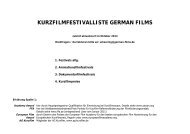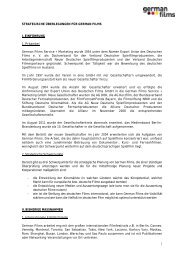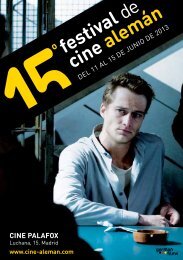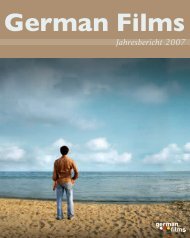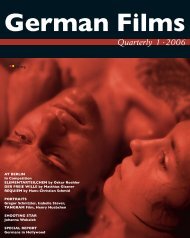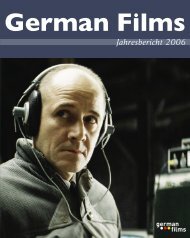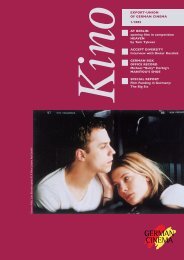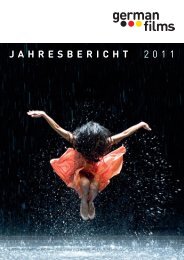Quarterly 4 · 2006 - German Cinema
Quarterly 4 · 2006 - German Cinema
Quarterly 4 · 2006 - German Cinema
Create successful ePaper yourself
Turn your PDF publications into a flip-book with our unique Google optimized e-Paper software.
Warhol and Kenneth Anger through Werner Nekes. As he edited his<br />
film Menu Total, he saw David Lynch’s Eraserhead. “I was flabbergasted.<br />
I had actually filmed a <strong>German</strong>, concretely chaotic, fascistic<br />
Eraserhead, but sensed that Lynch was doing something else. I always<br />
looked through the camera, I had a thousand scenes in my head, but<br />
not a complete film. It was a score in the 12-tone technique, although<br />
I only heard Schoenberg later.”<br />
All of his films follow this “score“. They consist of a thousand scenes<br />
and labor to be a complete film. They are fragmented like the land<br />
that they came from, and which also labors to be complete. There are<br />
no films from <strong>German</strong>y that are as authentically <strong>German</strong> as the skewed,<br />
kaput, screeching, tasteless ones in Schlingensief ’s Deutscher<br />
Trilogie – 100 Jahre Adolf Hitler: far ahead of Der Untergang<br />
and the psychogram of the fascist bourgeoisie that has gone wild.<br />
Das Deutsche Kettensaegemassaker: with the slaughter of<br />
the people from the GDR after the borders have fallen, the prophecy<br />
of the sell-out and spoilage of an entire society. Terror 2000: the<br />
hostage drama of <strong>German</strong>y, sensational and xenophobic.<br />
That he discovered “animatographs“ himself was logically consistent<br />
and the extension of the soul to the technique. Because his soul is full<br />
of fear of blindness (a disease that runs in his family). “I can still see,<br />
but I am already thinking of the darkness. I therefore also work under<br />
the motto: no movement without darkness. And that comes from the<br />
history of the cinema. Even with 18 frames per second, the picture<br />
seems to flow, but one still senses this flickering, this instability. I am<br />
unstable. At some point it goes black, and then I move into an empty<br />
space, into the world of pictures, there, where they melt together. I<br />
work at the point of this fusion. Therefore I also fuse some things<br />
together in thought which others do not want to fuse.“<br />
There can hardly be a more accurate analysis of and rationale behind<br />
the animatographs, that revolving stage on which the arrangement of<br />
booth-like segments show partial aspects of singular stories or sensations<br />
which the spectator must piece together. But at the end, no<br />
spectator has seen what another has. That is the philosophy of the<br />
performance artist Kaprow, which Schlingensief makes concrete and<br />
tangible, just as he made Joseph Beuys‘ rabbits tangible.<br />
From the first film of the seven-year-old to his African excursions, the<br />
theater works, installations, and performances, one of his most prominent<br />
talents remains the ability to move others to participate, well<br />
– to inspire them. Opera singers as well as state actors, old as well as<br />
young, white and black, professionals and amateurs. Whoever wants<br />
to remain tenacious. That was always convenient for him. They simply<br />
show what actors in their roles impel: eternal childhood.<br />
In his films as well as on the stage, he tolerates (seemingly) nothing<br />
less than professionalism. He is also very professional himself. In this<br />
way, he made dilettantism into an art form. His films only portray<br />
wrong connections; his arrangement in the theater, no sequence of<br />
scenes. There is only the presence of the eccentric presentation. His<br />
aesthetic is chaos, his homeland is Absurdistan. He puts the fuse on<br />
each powder keg and sparks fly, but it is always lust that wins; lust is<br />
the surplus value of his fury.<br />
Each new film is also a different film. Because new landscapes put a<br />
spell on his imagination again and again, because the torrent of his<br />
associations is the powerful Niagara, or because another exaggeration<br />
antagonizes him or another injustice or another political corruption<br />
sends him into a rage.<br />
The afterbirth of Dada and Surrealism is occasionally based on Luis<br />
Buñuel and he could also name Artaud and Jarry. Or Oskar Panizza<br />
and Otto Muehl. His anarchy is organized, his organization is anarchy.<br />
He is a character like Dali and worlds away from his vanity. Nobody<br />
can give better information about him than he, himself. He is the most<br />
competent regarding himself. And he is someone who controls himself<br />
like no one else. As wild, eccentric, and crazy as he – and what he<br />
produces – may appear to be, he acts consciously. His irrationality is<br />
rational, his rationality irrational. Ever since a life-threatening burst<br />
appendix, he thinks on a gut level and feels with his head. That is the<br />
only way he could stay what he remains today: the boy with the<br />
camera.<br />
Peter W. Jansen (author, film journalist, film critic, publicist)<br />
spoke with Christoph Schlingensief<br />
german films quarterly director’s portrait<br />
4 <strong>·</strong> <strong>2006</strong> 11



